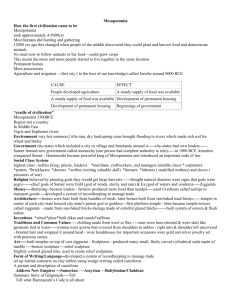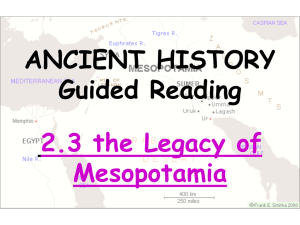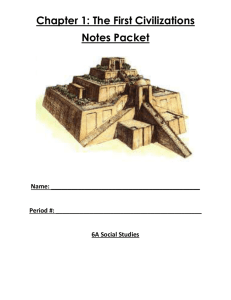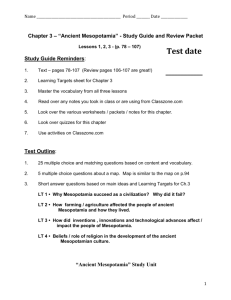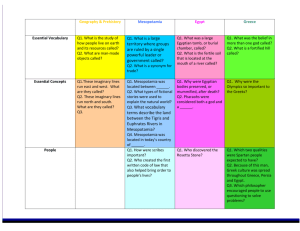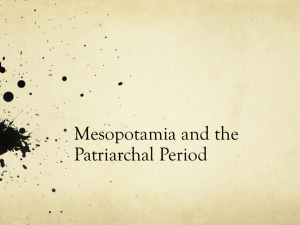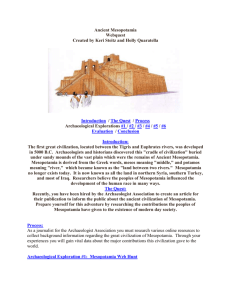Ancient Mesopotamia
advertisement
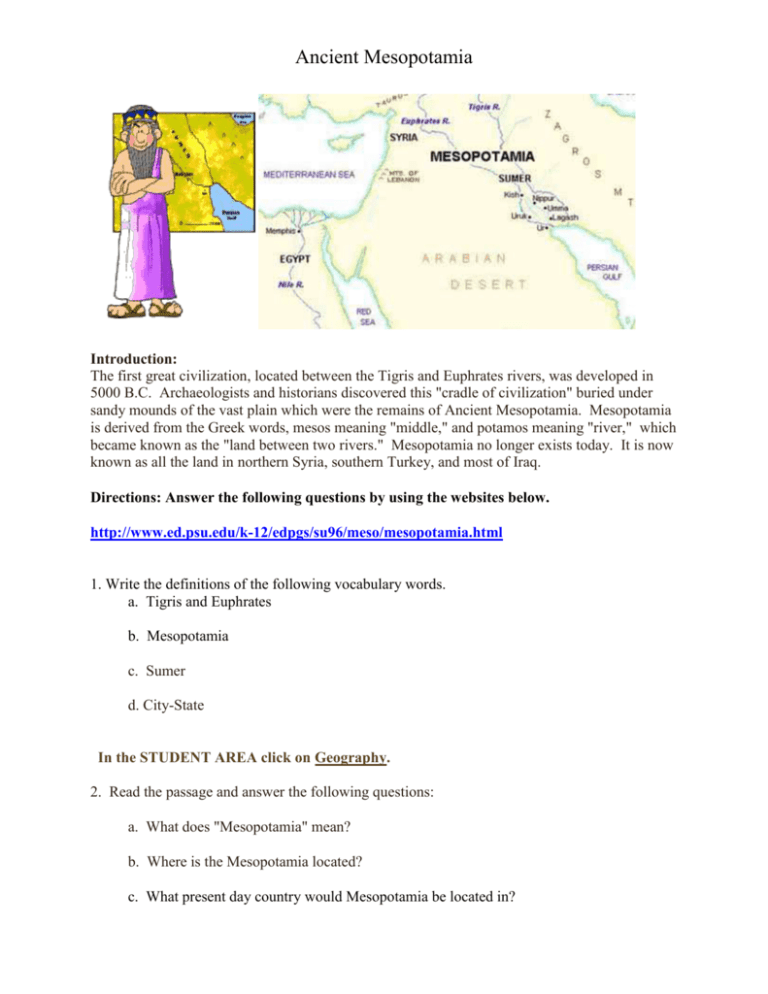
Ancient Mesopotamia Introduction: The first great civilization, located between the Tigris and Euphrates rivers, was developed in 5000 B.C. Archaeologists and historians discovered this "cradle of civilization" buried under sandy mounds of the vast plain which were the remains of Ancient Mesopotamia. Mesopotamia is derived from the Greek words, mesos meaning "middle," and potamos meaning "river," which became known as the "land between two rivers." Mesopotamia no longer exists today. It is now known as all the land in northern Syria, southern Turkey, and most of Iraq. Directions: Answer the following questions by using the websites below. http://www.ed.psu.edu/k-12/edpgs/su96/meso/mesopotamia.html 1. Write the definitions of the following vocabulary words. a. Tigris and Euphrates b. Mesopotamia c. Sumer d. City-State In the STUDENT AREA click on Geography. 2. Read the passage and answer the following questions: a. What does "Mesopotamia" mean? b. Where is the Mesopotamia located? c. What present day country would Mesopotamia be located in? In the STUDENT AREA click on The Sumerian City-State. 3. Read the passage The Sumerian City-State and answer the following questions: a. What people established the first civilization? b. What was at the center of each city-state? b. Describe the people that lived in the city-state. In the STUDENT AREA click on The Ziggurat. 4. Read the passage The Ziggurat and answer the following questions: a. The ____________________ was the first major building structure of the Sumerians. b. Who was housed in the ziggurat? In the STUDENT AREA click on Cuneiform. 5. Read the passage Cuneiform and answer the following questions: a. What is the name of the world's first writing system? b. What did the Sumerians write on? c. Did the Sumerians have the same writing we have today? In the STUDENT AREA click on Contributions. 6. Describe four contributions that the Sumerians made. 1. 2. 3. 4. Math Mesopotamia was a civilization full of many creations. The people of Mesopotamia developed a mathematical system based on the number 60. Other accomplishments included the creation of the first calendar and the worlds first clock: the sundial. The lasting effects of this on our culture is the 60-minute hour, 60-second minute, and 360 degrees in a circle. After reading the passage above click on the following web site to help in the completion of these ancient mathematical word problems. http://it.stlawu.edu/~dmelvill/mesomath/Numbers.html Ancient Mathematical Word Problems 1. Mesopotamia's king sent his slaves to buy 19 apples and 30 oranges but the slaves became very hungry. They ate 5 apples and 10 oranges. How much fruit did the slaves bring back to the king? Using cuneiform symbols SHOW ALL WORK. Explain how you found your answer. 2. The scribes made 12 clay tablets a day. How many clay tablets will they have in 5 days? (HINT: Use another method than addition.) Using cuneiform symbols SHOW ALL WORK. Explain how you found your answer. 3. The priest decided they wanted to have a feast in honor of the lugal or "king". They invited 50 guests. They set up 10 tables. How many guests could sit at each table? Using cuneiform symbols SHOW ALL WORK. Explain how you found your answer. Archaeology Exploration #6: Hammurabi, King of Babylon To further your knowledge on Hammurabi, King of Babylon, visit the site below. http://www.thenagain.info/WebChron/MiddleEast/Hammurabi.html 1. List 5 interesting facts about King of Hammurabi: 1. 2. 3. 4. 5. Click on Code of Hammurabi: 2. "If a son strikes his father, his hand shall be cut off." "If a man destroys the eye of another man, his eye shall be destroyed." "If he destroys the eye of a common (poor) man, he shall pay one mina of silver." These are laws from the Code of Hammurabi. Do you think they were fair for everyone? Why or Why not?




